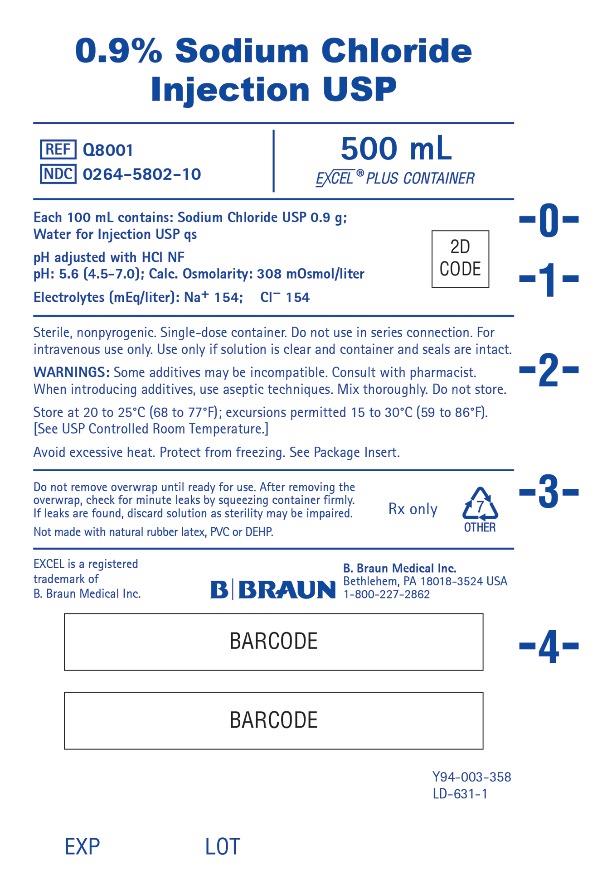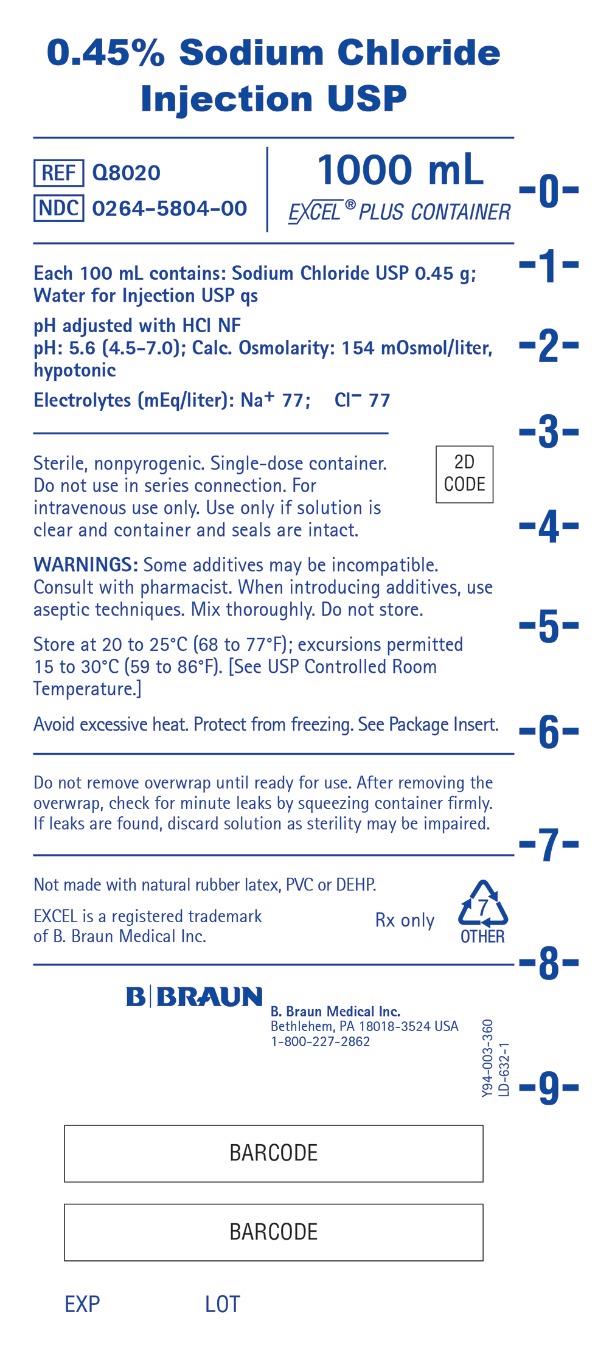Label: SODIUM CHLORIDE injection, solution
- NDC Code(s): 0264-5802-00, 0264-5802-10, 0264-5804-00
- Packager: B. Braun Medical Inc.
- Category: HUMAN PRESCRIPTION DRUG LABEL
Drug Label Information
Updated January 31, 2022
If you are a healthcare professional or from the pharmaceutical industry please visit this version.
- Download DRUG LABEL INFO: PDF XML
- Official Label (Printer Friendly)
-
DESCRIPTION
Each 100 mL of 0.9% Sodium Chloride Injection USP contains:
Sodium Chloride USP 0.9 g; Water for Injection USP qs
pH: 5.6 (4.5–7.0) Calculated Osmolarity: 308 mOsmol/liter
pH adjusted with Hydrochloric Acid NF
Concentration of Electrolytes (mEq/liter): Sodium 154 Chloride 154Each 100 mL of 0.45% Sodium Chloride Injection USP contains:
Sodium Chloride USP 0.45 g; Water for Injection USP qs
pH: 5.6 (4.5–7.0) Calculated Osmolarity: 154 mOsmol/liter, hypotonic
pH adjusted with Hydrochloric Acid NF
Concentration of Electrolytes (mEq/liter): Sodium 77 Chloride 77Sodium Chloride Injections USP are sterile, nonpyrogenic, isotonic and contain no bacteriostatic or antimicrobial agents.
The formula of the active ingredient is:
Ingredient Molecular Formula Molecular Weight Sodium Chloride USP NaCl 58.44 Not made with natural rubber latex, PVC or DEHP.
The plastic container is made from a multilayered film specifically developed for parenteral drugs. It contains no plasticizers and exhibits virtually no leachables. The solution contact layer is a rubberized copolymer of ethylene and propylene. The container is nontoxic and biologically inert. The container-solution unit is a closed system and is not dependent upon entry of external air during administration. The container is overwrapped to provide protection from the physical environment and to provide an additional moisture barrier when necessary.
Addition of medication should be accomplished using complete aseptic technique.
The closure system has two ports; the one for the administration set has a tamper evident plastic protector and the other is a medication addition site. Refer to the Directions for Use of the container.
-
CLINICAL PHARMACOLOGY
Sodium Chloride Injections USP provide electrolytes and are a source of water for hydration. They are capable of inducing diuresis depending on the clinical condition of the patient.
Sodium, the major cation of the extracellular fluid, functions primarily in the control of water distribution, fluid balance, and osmotic pressure of body fluids. Sodium is also associated with chloride and bicarbonate in the regulation of the acid-base equilibrium of body fluid.
Chloride, the major extracellular anion, closely follows the metabolism of sodium, and changes in the acid-base balance of the body are reflected by changes in the chloride concentration.
-
INDICATIONS AND USAGE
These intravenous solutions are indicated for use in adults and pediatric patients as sources of electrolytes and water for hydration.
0.9% Sodium Chloride Injection USP is indicated for extracellular fluid replacement, treatment of metabolic alkalosis in the presence of fluid loss and mild sodium depletion.
0.9% Sodium Chloride Injection USP is also indicated for use as a priming solution in hemodialysis procedures and may be used to initiate and terminate blood transfusions without hemolyzing red blood cells.
0.45% Sodium Chloride Injection USP is primarily a hydrating solution and may be used to assess the status of the kidneys, since more water is provided than is required for excretion of salt. It may also be used in the treatment of hyperosmolar diabetes where the use of dextrose is inadvisable and there is a need for large amounts of fluid without an excess of sodium ions.
Sodium Chloride Injections USP are also indicated as pharmaceutic aids and diluents for the infusion of compatible drug additives. Refer to prescribing information accompanying additive drugs.
- CONTRAINDICATIONS
-
WARNINGS
The administration of intravenous solutions can cause fluid and/or solute overload resulting in dilution of serum electrolyte concentrations, overhydration, congested states or pulmonary edema. The risk of dilutional states is inversely proportional to the electrolyte concentration. The risk of solute overload causing congested states with peripheral and pulmonary edema is directly proportional to the electrolyte concentration.
Solutions containing sodium ions should be used with great care, if at all, in patients with congestive heart failure, severe renal insufficiency, and in clinical states in which there is sodium retention with edema. In patients with diminished renal function, administration of solutions containing sodium ions may result in sodium retention.
Infusion of isotonic (0.9%) sodium chloride during or immediately after surgery may result in excessive sodium retention. Use the patient's circulatory system status as a guide.
-
PRECAUTIONS
General
Clinical evaluation and periodic laboratory determinations are necessary to monitor changes in fluid balance, electrolyte concentrations, and acid-base balance during prolonged parenteral therapy or whenever the condition of the patient warrants such evaluation. Significant deviations from normal concentrations may require tailoring of the electrolyte pattern, in these or alternative solutions.
These solutions should be used with care in patients with hypervolemia, renal insufficiency, urinary tract obstruction, or impending or frank cardiac decompensation.
Extraordinary electrolyte losses such as may occur during protracted nasogastric suction, vomiting, diarrhea or gastrointestinal fistula drainage may necessitate additional electrolyte supplementation.
Additional essential electrolytes, minerals and vitamins should be supplied as needed.
Sodium-containing solutions should be administered with caution to patients receiving corticosteroids or corticotropin, or to other salt-retaining patients. Care should be exercised in administering solutions containing sodium to patients with renal or cardiovascular insufficiency, with or without congestive heart failure, particularly if they are postoperative or elderly.
Infusion of more than one liter of isotonic (0.9%) sodium chloride per day may supply more sodium and chloride than normally found in serum, and can exceed normal tolerance, resulting in hypernatremia; this may also cause a loss of bicarbonate ions, resulting in an acidifying effect.
To minimize the risk of possible incompatibilities arising from mixing this solution with other additives that may be prescribed, the final infusate should be inspected for cloudiness or precipitation immediately after mixing, prior to administration and periodically during administration.
Do not use plastic containers in series connection.
If administration is controlled by a pumping device, care must be taken to discontinue pumping action before the container runs dry or air embolism may result. If administration is not controlled by a pumping device, refrain from applying excessive pressure (>300mmHg) causing distortion to the container such as wringing or twisting. Such handling could result in breakage of the container.
These solutions are intended for intravenous administration using sterile equipment. It is recommended that intravenous administration apparatus be replaced at least once every 24 hours.
Use only if solution is clear and container and seals are intact.
Carcinogenesis, Mutagenesis, Impairment of Fertility
Studies with Sodium Chloride Injections USP have not been performed to evaluate carcinogenic potential, mutagenic potential or effects on fertility.
Pregnancy:
Teratogenic Effects
Animal reproduction studies have not been conducted with Sodium Chloride Injections USP. It is also not known whether Sodium Chloride Injections USP can cause fetal harm when administered to a pregnant woman or can affect reproduction capacity. Sodium Chloride Injections USP should be given to a pregnant woman only if clearly needed.
Nursing Mothers
It is not known whether this drug is excreted in human milk. Because many drugs are excreted in human milk, caution should be exercised when Sodium Chloride Injections USP are administered to a nursing woman.
Pediatric Use
Safety and effectiveness of sodium chloride injections in pediatric patients have not been established by adequate and well controlled trials, however, the use of electrolyte solutions in the pediatric population is referenced in the medical literature. The warnings, precautions and adverse reactions identified in the label copy should be observed in the pediatric population.
Geriatric Use
An evaluation of current literature revealed no clinical experience identifying differences in response between elderly and younger patients. In general, dose selection for an elderly patient should be cautious, usually starting at the low end of the dosing range, reflecting the greater frequency of decreased hepatic, renal, or cardiac function, and of concomitant disease or other drug therapy.
This drug is known to be substantially excreted by the kidney, and the risk of toxic reactions may be greater in patients with impaired renal function. Because elderly patients are more likely to have decreased renal function, care should be taken in dose selection, and it may be useful to monitor renal function.
-
ADVERSE REACTIONS
Reactions which may occur because of the solution or the technique of administration include febrile response, infection at the site of injection, venous thrombosis or phlebitis extending from the site of injection, extravasation and hypervolemia. Anaphylaxis has occasionally been reported.
The physician should also be alert to the possibility of adverse reactions to drug additives. Prescribing information for drug additives to be administered in this manner should be consulted.
Symptoms may result from an excess or deficit of one or more of the ions present in the solution; therefore, frequent monitoring of electrolyte levels is essential.
Hypernatremia may be associated with edema and exacerbation of congestive heart failure due to the retention of water, resulting in an expanded extracellular fluid volume. Cerebral edema and myelinolysis have been reported.
If infused in large amounts, chloride ions may cause a loss of bicarbonate ions, resulting in an acidifying effect.
If an adverse reaction does occur, discontinue the infusion, evaluate the patient, institute appropriate therapeutic countermeasures, and save the remainder of the fluid for examination if deemed necessary.
- OVERDOSAGE
-
DOSAGE AND ADMINISTRATION
These solutions are for intravenous use only.
Dosage is to be directed by a physician and is dependent upon age, weight, clinical condition of the patient and laboratory determinations. Frequent laboratory determinations and clinical evaluation are essential to monitor changes in blood glucose and electrolyte concentrations, and fluid and electrolyte balance during prolonged parenteral therapy.
In the average adult, daily requirements of sodium and chloride are met by the infusion of one liter of 0.9% sodium chloride (154 mEq each of sodium and chloride).
There is no specific pediatric dose. The dose is dependent on weight, clinical condition and laboratory results. Follow recommendations of appropriate pediatric reference text. (See PRECAUTIONS, Pediatric Use.)
Fluid administration should be based on calculated maintenance or replacement fluid requirements for each patient.
0.9% Sodium Chloride Injection USP may also be administered intravascularly as a priming fluid in hemodialysis procedures.
When Sodium Chloride Injections USP are used as diluents for infusion of compatible drug additives, refer to dosage and administration information accompanying additive drugs.
Some additives may be incompatible. Consult with pharmacist. When introducing additives, use aseptic techniques. Mix thoroughly. Do not store.
Parenteral drug products should be inspected visually for particulate matter and discoloration prior to administration, whenever solution and container permit.
-
HOW SUPPLIED
Sodium Chloride Injections USP are supplied sterile and nonpyrogenic in EXCEL® Plus Containers. The 1000 mL containers are packaged 12 per case; the 500 mL containers are packaged 24 per case.
NDC REF Size 0.9% Sodium Chloride Injection USP
0264-5802-00 Q8000 1000 mL 0264-5802-10 Q8001 500 mL 0.45% Sodium Chloride Injection USP
0264-5804-00 Q8020 1000 mL - SPL UNCLASSIFIED SECTION
-
Directions for Use of EXCEL® Plus Container
Caution: Do not use plastic containers in series connection.
To Open
Tear overwrap down at notch and remove solution container. Check for minute leaks by squeezing solution container firmly. If leaks are found, discard solution as sterility may be impaired. If supplemental medication is desired, follow directions below before preparing for administration.
NOTE: Before use, perform the following checks:
- Inspect each container. Read the label. Ensure solution is the one ordered and is within the expiration date.
- Invert container and carefully inspect the solution in good light for cloudiness, haze, or particulate matter. Any container which is suspect should not be used.
- Use only if solution is clear and container and seals are intact.
Preparation for Administration
- Remove foil cover from sterile set port at bottom of container as shown in Figure A, Steps 1 and 2.
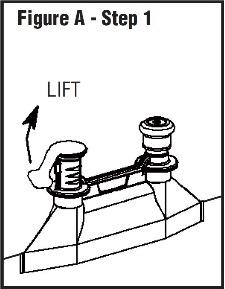
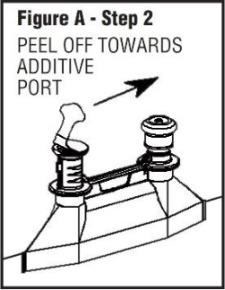
- Attach administration set. Refer to complete directions accompanying set.
To Add Medication
Warning: Some additives may be incompatible.
To Add Medication Before Solution Administration
- Prepare medication site.
- Using syringe with 18–22 gauge needle, puncture medication port and inner diaphragm and inject.
- Squeeze and tap ports while ports are upright and mix solution and medication thoroughly.
To Add Medication During Solution Administration
- Close clamp on the set.
- Prepare medication site.
- Using syringe with 18–22 gauge needle of appropriate length (at least 5/8 inch), puncture resealable medication port and inner diaphragm and inject.
- Remove container from IV pole and/or turn to an upright position.
- Evacuate both ports by tapping and squeezing them while container is in the upright position.
- Mix solution and medication thoroughly.
- Return container to in use position and continue administration.
- SPL UNCLASSIFIED SECTION
-
PRINCIPAL DISPLAY PANEL - 0.9 g/1000 mL Container Label
0.9% Sodium Chloride
Injection USPREF Q8000
NDC 0264-5802-00
1000 mL
EXCEL® PLUS CONTAINEREach 100 mL contains: Sodium Chloride USP 0.9 g;
Water for Injection USP qspH adjusted with HCl NF
pH: 5.6 (4.5-7.0); Calc. Osmolarity: 308 mOsmol/literElectrolytes (mEq/liter): Na+ 154; Cl– 154
Sterile, nonpyrogenic. Single-dose container. Do not use in
series connection. For intravenous use only. Use only if
solution is clear and container and seals are intact.WARNINGS: Some additives may be incompatible. Consult
with pharmacist. When introducing additives, use aseptic
techniques. Mix thoroughly. Do not store.Store at 20 to 25°C (68 to 77°F); excursions permitted 15 to 30°C (59 to 86°F). [See USP Controlled Room Temperature.]
Avoid excessive heat. Protect from freezing. See Package Insert.
Do not remove overwrap until ready for use. After removing the
overwrap, check for minute leaks by squeezing container firmly. If
leaks are found, discard solution as sterility may be impaired.Not made with natural rubber latex, PVC or DEHP.
Rx only

EXCEL is a registered trademark of B. Braun Medical Inc.
B. Braun Medical Inc.
Bethlehem, PA 18018-3524 USA
1-800-227-2862
Y94-003-357
LD-630-1EXP
LOT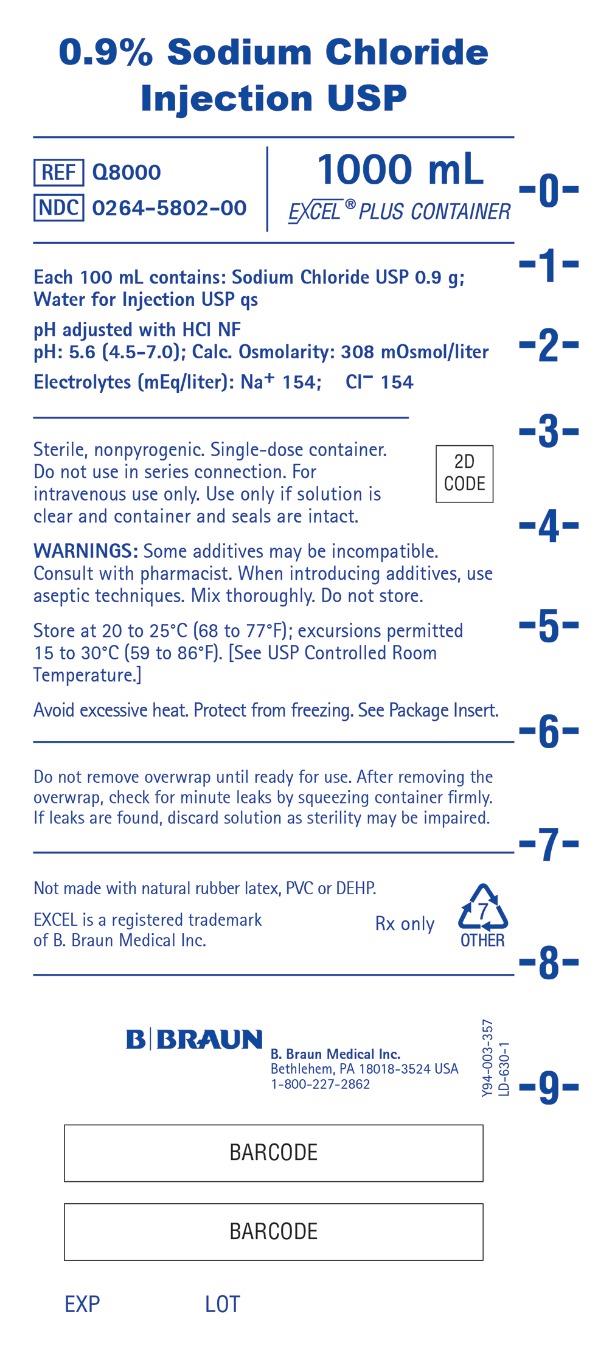
-
PRINCIPAL DISPLAY PANEL - 0.9 g/500 mL Container Label
0.9% Sodium Chloride
Injection USPREF Q8001
NDC 0264-5802-10
500 mL
EXCEL® PLUS CONTAINEREach 100 mL contains: Sodium Chloride USP 0.9 g;
Water for Injection USP qspH adjusted with HCl NF
pH: 5.6 (4.5–7.0); Calc. Osmolarity: 308 mOsmol/literElectrolytes (mEq/liter): Na+ 154; Cl– 154
Sterile, nonpyrogenic. Single-dose container. Do not use in series
connection. For intravenous use only. Use only if solution is clear and
container and seals are intact.WARNINGS: Some additives may be incompatible. Consult with
pharmacist. When introducing additives, use aseptic techniques. Mix
thoroughly. Do not store.Store at 20 to 25°C (68 to 77°F); excursions permitted 15 to 30°C (59 to 86°F). [See USP Controlled Room Temperature.]
Avoid excessive heat. Protect from freezing. See Package Insert.
Do not remove overwrap until ready for use. After removing the overwrap, check for
minute leaks by squeezing container firmly. If leaks are found, discard solution as
sterility may be impaired.Not made with natural rubber latex, PVC or DEHP.
Rx only

EXCEL is a registered trademark of B. Braun Medical Inc.
B. Braun Medical Inc.
Bethlehem, PA 18018-3524 USA
1-800-227-2862
Y94-003-358
LD-631-1EXP
LOT
-
PRINCIPAL DISPLAY PANEL - 0.45 g/1000 mL Container Label
0.45% Sodium Chloride
Injection USPREF Q8020
NDC 0264-5804-00
1000 mL
EXCEL® PLUS CONTAINEREach 100 mL contains: Sodium Chloride USP 0.45 g;
Water for Injection USP qspH adjusted with HCl NF
pH: 5.6 (4.5-7.0); Calc. Osmolarity: 154 mOsmol/liter,
hypotonicElectrolytes (mEq/liter): Na+ 77; Cl– 77
Sterile, nonpyrogenic. Single-dose container. Do not use in
series connection. For intravenous use only. Use only if
solution is clear and container and seals are intact.WARNINGS: Some additives may be incompatible. Consult
with pharmacist. When introducing additives, use aseptic
techniques. Mix thoroughly. Do not store.Store at 20 to 25°C (68 to 77°F); excursions permitted 15 to 30°C (59 to 86°F). [See USP Controlled Room Temperature.]
Avoid excessive heat. Protect from freezing. See Package Insert.
Do not remove overwrap until ready for use. After removing the
overwrap, check for minute leaks by squeezing container firmly. If
leaks are found, discard solution as sterility may be impaired.Not made with natural rubber latex, PVC or DEHP.
Rx only

EXCEL is a registered trademark of B. Braun Medical Inc.
B. Braun Medical Inc.
Bethlehem, PA 18018-3524 USA
1-800-227-2862
Y94-003-360
LD-632-1EXP
LOT
-
INGREDIENTS AND APPEARANCE
SODIUM CHLORIDE
sodium chloride injection, solutionProduct Information Product Type HUMAN PRESCRIPTION DRUG Item Code (Source) NDC:0264-5802 Route of Administration INTRAVENOUS Active Ingredient/Active Moiety Ingredient Name Basis of Strength Strength SODIUM CHLORIDE (UNII: 451W47IQ8X) (SODIUM CATION - UNII:LYR4M0NH37, CHLORIDE ION - UNII:Q32ZN48698) SODIUM CHLORIDE 0.9 g in 100 mL Inactive Ingredients Ingredient Name Strength WATER (UNII: 059QF0KO0R) HYDROCHLORIC ACID (UNII: QTT17582CB) Packaging # Item Code Package Description Marketing Start Date Marketing End Date 1 NDC:0264-5802-00 12 in 1 CASE 01/26/2022 1 1000 mL in 1 CONTAINER; Type 0: Not a Combination Product 2 NDC:0264-5802-10 24 in 1 CASE 01/26/2022 2 500 mL in 1 CONTAINER; Type 0: Not a Combination Product Marketing Information Marketing Category Application Number or Monograph Citation Marketing Start Date Marketing End Date NDA NDA019635 03/09/1998 SODIUM CHLORIDE
sodium chloride injection, solutionProduct Information Product Type HUMAN PRESCRIPTION DRUG Item Code (Source) NDC:0264-5804 Route of Administration INTRAVENOUS Active Ingredient/Active Moiety Ingredient Name Basis of Strength Strength SODIUM CHLORIDE (UNII: 451W47IQ8X) (SODIUM CATION - UNII:LYR4M0NH37, CHLORIDE ION - UNII:Q32ZN48698) SODIUM CHLORIDE 0.45 g in 100 mL Inactive Ingredients Ingredient Name Strength WATER (UNII: 059QF0KO0R) HYDROCHLORIC ACID (UNII: QTT17582CB) Packaging # Item Code Package Description Marketing Start Date Marketing End Date 1 NDC:0264-5804-00 12 in 1 CASE 01/26/2022 1 1000 mL in 1 CONTAINER; Type 0: Not a Combination Product Marketing Information Marketing Category Application Number or Monograph Citation Marketing Start Date Marketing End Date NDA NDA019635 03/09/1988 Labeler - B. Braun Medical Inc. (002397347)




